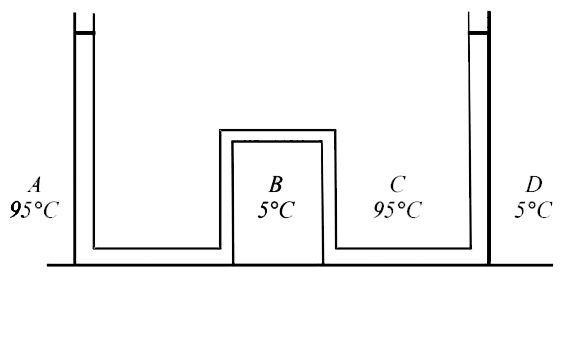In figure shown, left arm of a U−tube is immersed in a hot water bath at temperature t∘C, and right arm is immersed in a bath of melting ice, the height of manometric liquid in respective column is h1 and h0. Determine the coefficient of expansion of the liquid.
_S01_006_Q01.png)
The correct Answer is:γ=[(h1−h0)/h0t]
Step by step video solution for In figure shown, left arm of a U-tube is immersed in a hot water bath at temperature t^(@)C, and right arm is immersed in a bath of melting ice, the height of manometric liquid in respective column is h_(1) and h_(0). Determine the coefficient of expansion of the liquid. by Physics experts to help you in doubts & scoring excellent marks in Class 11 exams.
Updated on:21/07/2023Similar Questions
Two vertical glass tibes filled with a liquid are connected at their lower ends by a horizontal capillary tube. One tube is surrounded by a bath containing ice and water at 0∘C and the other by hot water a t∘C. The difference in the height of the liquid in the two columns is Δh, and the height of the colume at 0∘C is h0. coefficient of volume expansion of the liquid is.

View SolutionThe apparatus shown in the figure consists of four glass columns connected by horizontal section. The height of two central column B and C are 49 cm each. The two outer columns A and D are open to the temperature. A and C are maintained at a temperature of 95∘C while the columns B and D are maintained at 5∘C. The height of the liquid in A and D measured from the base the are 52.8 cm and 51cm respectively. Determine the coefficient of thermal expansion of the liquid

View SolutionThe apparatus shown in the figure consists of four glass columns connected by horizontal section. The height of two central column B and C are 49 cm each. The two outer columns A and D are open to the temperature. A and C are maintained at a temperature of 95∘C while the columns B and D are maintained at 5∘C. The height of the liquid in A and D measured from the base the are 52.8 cm and 51cm respectively. Determine the coefficient of thermal expansion of the liquid

View SolutionIn a vertical U-tube containing a luquid, the two arms are maintained at different temperatures, t1 and t2 . The liquid coplumns in the two arms have heights l1 and l2 respectively. The coefficient of volume expansion of the liquid is equal to

View SolutionA metallic bob weights 50g in air. If it is immersed in a liquid at a temperature of 25∘C, it weights 45g . When the temperature of the liquid is raised to 100∘C, it weights 45.1g. Calculate the coefficient of cubical expansion of the liquid. Given that coefficient of cubical expansion of the metal is 12×10−6.∘C−1.
View SolutionA sphere of diameter 7.0 cm and mass 266.5 g float in a bath of liquid. As the temperature is raised, the sphere begins to sink at a temperature of 350C. If the density of liquid is 1.527gcm−3 at 0oC, find the coefficient of cubical expansion of the liquid. Neglect the expansion of the sphere.
View SolutionA sphere of diameter 7.0 cm and mass 266.5 g float in a bath of liquid. As the temperature is raised, the sphere begins to sink at a temperature of 35∘C. If the density of liquid is 1.527gcm−3 at0∘C, find the coefficient of cubical expansion of the liquid. Neglect the expansion of the sphere.
View SolutionA non-conductiong body floats in a liquid at 25∘C with 1/3 of its volume immersed in the liquid. When liquid temperature is increased to 105∘C, 1/2 of body's volume is immersed is the liquid. Then, find the coefficient of real expansion of the liqquid (neglecting the expansion of container of the liquid) .
View SolutionA sphete of deamrter 7.0 cm and mass 266.5 g float in a bath of liquid. As the temperature is raised, the sphere begins to sink at a temperature of 35∘C. If the density of liqued is 1.527gcm−3 at0∘C, find the coeffiecient of cubical expamsion of the liquid. Neglect the expansion of the sphere.
View SolutionA solid body floats in a liquid at a temperature t=50∘C being completely submerged in it. What percentage of the volume of the body is submerged in the liquid after it is cooled to t0=0∘C, if the coefficient of cubic expansion for the solid is γs=0.3×10−5.∘C−1 and of the liquid γl=8×10−5.∘C−1.
View Solution